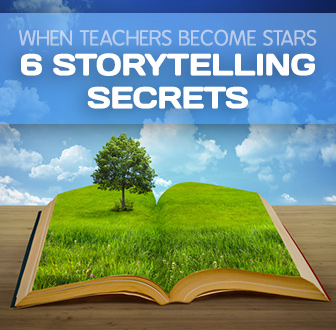Make the classroom your stage and become the most interesting visual aid ever by being the best storyteller your students have ever seen.
Don’t you want your reading sessions to be something the children look forward to? Of course, you do! So take on the next step and get out of that chair high above everyone else in the room. Make your students feel like they are watching their favorite show on television – or even better! Let me echo to you these tips shared by one of my favorite professors in our very own storytelling workshop in our class!

Here are 6 ways for you to try:
-
1
Choose a Book You Love
This professor said that when picking out a book to share to the class, make sure it is “something you are in love with”. You have to believe in the story yourself. Through this, you have a personal motivation in telling it to the class. You want your students to experience what you went through when you were reading the book; it may be that awfully nice and warm feeling that convinced you that the book needs to be shown to the world. You want to give justice to it. Bringing out the emotions you have with the book may also come just naturally. The story becomes real to the students because it is real to you. Nothing beats that.
-
2
Set the Stage
Another great tip from my teacher: From the moment you hold up the book in front of your students, make them feel you are about to say something special, something important, something that they need to know. Here are questions she wanted us to ask ourselves in our workshop: “What do you want to make them feel at the beginning of the story?”, “What are you setting them up for?”.
Create the feeling of thrill and enthusiasm in the students early on. She said that if you are telling a story with a happy ending, smile once you face your class and read the title of the book you have in your hands. I took it as, “Make yourself look like you are so excited to tell the story that you cannot stop smiling and are almost jumping out of your seat!” If you have caught their attention, the challenge now, she revealed, is to maintain their interest throughout the story.
-
3
Own the Characters
To do this, “come prepared for the session,” she said. Read how the author portrayed the characters. Be sure that you depict each one accurately and give justice to all of them. Even if the characterizations are complex, you still have to be convincing of your different roles.
Change the tone and pitch of your voice. Learn how to sound ecstatic, angry, confused, or nonchalant. In doing all these things, keep in mind that you have to be consistent in portraying every role. She reminded that each character should be clear in the minds of the students. She also noted that the storyteller should not rush to the end of the book. I think that this was the one I had the biggest challenge with! I used to just go on and on with the pages. What about you?
-
4
Take Note of Important Points in the Story
Pause. Louden your voice. Ask a question. Make sure you stop at certain parts of the story that need more time in the spotlight. These points, however, should be relevant and valuable to the story and worth the extra time you are allotting for them.
Among others, have the students realize the causes and effects, conflicts, and crucial actions in the story. This will help them identify the major parts & understand the story better.
-
5
Make the Students as Involved as Possible
The storytelling inside the classroom is primarily for the students. Make them enjoy every bit of it, and if possible, interact with as many parts of the story in focus. Have them repeat lines you read from the book. Instruct them to create a certain sound or perform a specific action each time a word identified earlier is mentioned at different points in the story. Ask them questions periodically. Let them point to pictures from the book. (Among all that I learned in the workshop, this was my favorite!)
-
6
Be Ridiculous
There is a reason why children adore cartoons. It is because they are funny and animated. So let yourself loose for a couple of minutes! Internalize just like what real actors and actresses do, leave all inhibitions behind, and do not be afraid to look crazy in front of your students. The goal of the activity, for one, is to make your class exposed to reading. And if you have an objective, you do everything to achieve that, right? So do what you have to do, and most importantly, have fun, so your students will do so, too. Being funny and nutty seems to be a popular opinion among other storytellers as well!
Here’s the last piece of advice from my teacher, who you know by now, is one great storyteller: The next time you dive into a storytelling session, put into mind that it is your duty to bring out that magic in books and to let your students see this magic.
You will be a star in your own right!
P.S. If you enjoyed this article, please help spread it by clicking one of those sharing buttons below. And if you are interested in more, you should follow our Facebook page where we share more about creative, non-boring ways to teach English.







